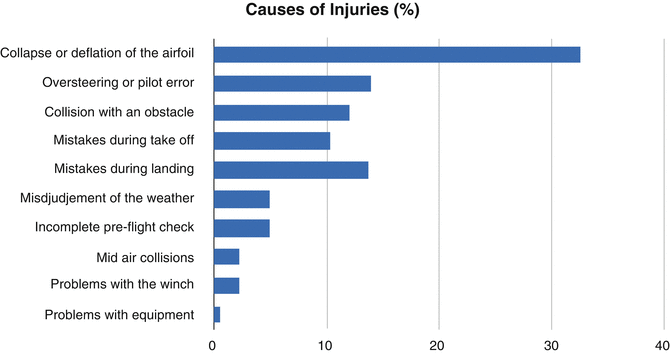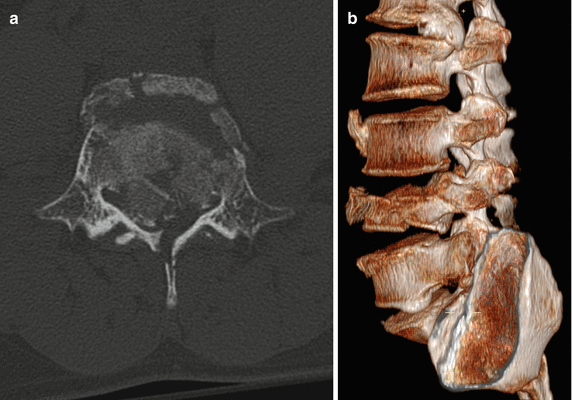Fig. 17.1
Hang gliding: landing in Florida Ridge, Miami, Florida, USA
). During their flight, pilots are suspended from the glider by a special prone harness, and they control the glider by moving their weight in relation to the control bar. Flying a hang glider is a little more difficult to learn than flying a paraglider and somewhat more demanding, but hang gliders can reach much higher speeds, achieve better gliding performance, and can fly in stronger winds [2]. Although it is possible to perform acrobatics, the vast majority of pilots prefer soaring. Hang gliding competitions are held at national and international levels, and hang gliding is one of the competition categories in the World Air Games organized by the Fédération Aéronautique Internationale (FAI) which maintains the chronology of the FAI World Hang Gliding Championships [3].
17.2.1 Causes of Injuries and Fatalities
Multiple reasons can lead to unsuccessful hang gliding flights resulting in injuries and even fatalities. These include insufficient training and incorrect use of technical equipment as well as misjudgment of weather conditions [12, 13, 15]. In particular, gusty or strong wind conditions have been reported as a determining or contributing cause of incidents in several studies [1, 4, 12, 13, 15, 16]. Given that the aim of the sport is to stay aloft in rising air, launching in the presence of thermal activity is common. Thermals moving at ground level can manifest as gusts, changing the intensity or the direction of the wind both laterally and vertically. Since hang gliders generally land at about 15 mph, a change in wind speed of around 10 mph may be enough to destabilize their flight. Additionally, nearly all hang gliders employ weight shift as their primary control method, where body movement causes changes in pitch (nose up/down) and roll, and strong gusts of wind can easily interfere with this means of control.
Pilot skill plays an important role in safety, and expert pilots have much wider margins of safety in any given weather condition. However, skilled pilots frequently monopolize that margin by taking greater risks such as gliding in bad weather conditions or by using uncertified equipment that can lead to incidents [6]. This is probably why hang gliders with little experience most frequently sustain nonfatal injuries, while pilots with more than 200 flights have a higher rate of fatal incidents [17].
Although equipment failures were uncommonly reported as a cause of incidents and generally did not result in serious events [4, 7–11], inadequate checking of equipment or planning of flights may cause fatal events [18]. The use of alcohol and drugs was also reported as a cause of incidents resulting in injuries or fatalities in some studies [6, 15, 19].
17.2.2 Dynamic of Injuries
Out of 127 hang gliding incidents reported by the United States Hang Gliding and Paragliding Association (USHPA) in the period between 2003 and 2013, 32.2 % (n = 41) occurred during takeoff, 36.2 % (n = 46) during landing, and 15.7 % (n = 20) in flight. Sixteen (12.6 %) towing launch incidents were also reported [11].
17.2.2.1 Takeoff
The most severe injuries are reported immediately after takeoff [4]. The majority of hang gliding takeoff incidents were attributed to insufficient airspeed. This situation can be determined by a launch run which is too brief or too slow causing pushing out or failure to control pitch attitude and angle-of-attack during the launch run [7]. Crosswinds, turbulence or gusty winds can also cause incidents during takeoff. In towed launches, incidents can be due to early releases, releases with insufficient altitude/airspeed or incorrect attachments [7].
17.2.2.2 Flight
17.2.2.3 Landing
The most frequent injuries are reported as a result of landing problems, particularly uncontrolled landings after stalling and landings on hostile ground [5, 6]. Incidents in the landing phase can be caused by uncontrolled contact with the ground while maneuvering to land. This can happen with modern high performance gliders in particular because they tend to accelerate quickly and can rapidly develop high sink rates during un-coordinated turns [11]. Obstacles in the landing zone can contribute to incidents. Precise piloting is paramount on approach. Even minor contact of one wing with an obstruction such as a tree can result in loss of airspeed and rapid yaw, pitch and roll with insufficient altitude for recovery.
17.2.3 Injuries and Fatalities
The extent and severity of reported injuries range from skin lacerations to permanent neurological findings following injuries to the brain or spinal cord. Multiple injuries are common in hang gliding incidents and are reported in most studies [6]. The pilot is suspended from the glider by the harness in a prone position meaning that the head, the upper extremities and the trunk are in a fixed position and prone to injuries. Head injuries are reported as occurring in up to 23 % of cases in the cross-sectional studies and up to 27 % in case series [6]. According to the same reports, the frequency of trunk, spine or spinal cord injuries is between 1 and 34 %, and that of upper extremity injuries is up to 80 % while injuries to the lower extremities is up to 43 % of cases [6]. Some cases of burn injuries related to hang gliding into electrical wires have also been described [6, 14]. The reported fatalities were due to many causes: polytrauma, heart laceration, aorta rupture, pulmonary collapse, skull fractures with brain damage, retroperitoneal hemorrhage and thoracic and cervical spinal cord injury [6, 12, 17, 18]. In their study on fatal aviation incidents, Ast et al. [19] also reported two hang gliding crashes caused by pilot error or loss of aircraft control as a consequence of heart failure. Both cases were attributed to preexisting severe stenosing coronary sclerosis.
17.3 Paragliding
Paragliding is an aerial sport where the pilot flies a modified parachute called a paraglider wing (Fig. 17.2
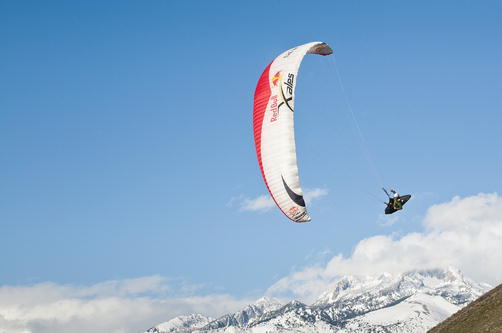
). Paraglider wings derived from skydiving canopies in the 1960s and still have the same fabric cell structure inflated by the wind. They are however not designed to tolerate the terminal velocity opening shock that sport parachutes are required to handle. While parachutes are required to be stronger and employ a staged opening to spread the opening shock (a deceleration from about 120 mph to less than 15 mph in just a few seconds), paraglider wings are designed to stay open and to reopen immediately in case of a wing fold or collapse. Indeed, the wing can fold in various ways, especially when flying in turbulence, usually causing a turn. Although the same phenomenon can affect skydiving canopies, the level of turbulence required is much greater, making it an extremely rare event.

Fig. 17.2
Red Bull athlete photo shoot with Honza Rejmanek training for the 2011 X-Alps competition in Salt Lake City, Utah. (Photo courtesy of Red Bull Content Pool/Michael Clark)
In paragliding, the pilot is suspended from the wing by a network of suspension lines connected to a harness offering support in both the standing and sitting positions. Paragliding requires a slope in order to take off. The wing is inflated by an airstream either from an existing wind or one created by running. Launching is also possible by tow. The pilot uses hand controls called “brakes” connected to the trailing edge of both sides of the wing to adjust speed, steer, and flare during landing. The wing can also be steered by pilots shifting their weight. An additional foot control called the speed bar or accelerator attached to the paragliding harness and connected to the leading edge of the wing allows the pilot to increase speed by decreasing the wing’s angle of attack. The vast majority of pilots use efficient types of specific wings for soaring. These exploit the rising air from thermals or lifted air over geographic obstructions such as ridges and mountains.
Different wing types are available, depending on their intended use. Special smaller wings (mini-wings and speed-wings) with more responsive handling and capable of higher speeds have recently been developed (Fig. 17.3) and are used in various disciplines including speed riding and speed flying. In speed flying, a wing about half the size of an average paraglider wing is used to fly in close proximity to a steep slope, generally in strong winds, while speed riding (or ski gliding) is a winter specialty practiced using skis.
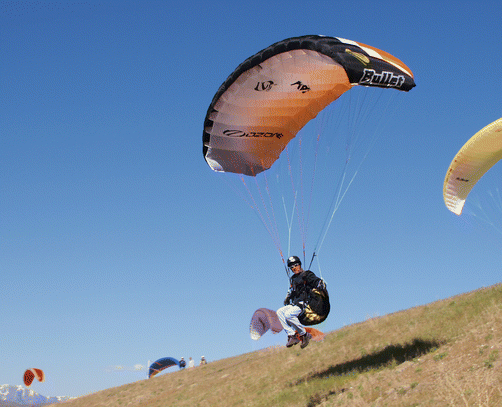

Fig. 17.3
Steve Mayer flying an early speed-wing at Point of the Mountain, Salt Lake City, Utah, USA
17.3.1 Causes of Injury Events
According to the data collected by the German Paragliding Association, pilot carelessness, lack of experience, changes in wind conditions, and technical failure emerged as the main reasons for incidents from a detailed analysis performed by Schulze et al. [20] on 409 paragliding incidents (Fig. 17.4
).
).
Alpine areas were at higher risk of incidents because of environmental dangers such as tight landing zones, strong valley winds and turbulent thermal conditions, while flights in lowland areas were significantly less dangerous [20].
Beginners and recreational pilots with less than 100 flights were most prone to incidents [20].
17.3.2 Dynamics of Injury Events
The most common dynamic causing approximately one third of incidents is glider collapse or deflation (Fig. 17.5
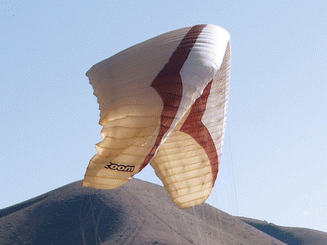
) often occurring following turbulence or gusts of wind. When the pilot is unable to recover from this dynamic, the result is a collision with the ground or with an obstacle [20, 21].

Fig. 17.5
Asymmetrical collapse. In the series by Schulze et al., an asymmetrical collapse (85.1 %) was a more common cause of incidents than a frontal collapse (15.9 %) [20]
Incidents can occur in every phase of flight, but the most frequent incident types occur on landing. In a retrospective study by Zeller et al. on 376 non-fatal paragliding incidents, 48.7 % occurred during landing, 35.1 % during takeoff, and 16.2 % during flight [21].
17.3.2.1 Takeoff
During takeoff, pilots usually sustain low-energy trauma to the ankle and the upper extremities caused by falls during the fast run downhill required to inflate the wing. Major spinal injuries reported during takeoff were due to an overestimation of wing lift causing the pilot to sit back too early resulting in slamming the buttocks on the ground [21].
Other less common causes of incidents were due to problems with the winch in towed launches. In these cases, injuries were generally caused by backlash from breakage of the towing cord. An incomplete pre-flight check can also cause incidents. Four fatal events reported by Schulze et al. were caused by failure of pilots to fasten the leg loops causing them to fall out on takeoff. Another incident dynamic was taking off with tangled or knotted lines [20].
17.3.2.2 Flight
During flights, a stall or collapse of the canopy (usually as a consequence of turbulence) can cause crashes from a great height leading to multiple injuries including fractures to the spine, pelvis and lower extremities. One highly dangerous situation involves the tips of the paraglider becoming entangled in its own lines following a full or partial stall resulting in spinning. This situation normally occurs almost exclusively among sport class, high-performance or competitive paragliders (categories 2 and 3 as per the quality categories used by the German Paragliding Association, the ACFPULS – Association des Constructeurs Français de Planeurs Ultra-Légers Souples/French Designing Engineers Association of Microlight Planes and the SHV – Schweiserischer Hängegleiterverband/Swiss Paragliding Association) [20]. Mid-air collisions with other paragliders or hang gliders are possible but rare events (2.2 %; n = 9) [20].
17.3.2.3 Landing
Mistakes during landing include landing with a tailwind, incorrect approach (too high or too low), fast curves close to the ground, and sudden, erroneous correction of direction [20]. In 13.9 % (n = 57) of the cases reported by Schulze et al. [20], incidents happened as a result of oversteering or pilot error which is most often a consequence of incorrect break-line handling during high-speed descent maneuvers including B-line stall, parachute flight, big ears or steep spirals [20]. Major injuries during landing are generally the result of an excessively rapid descent due to turbulence or pilot error [21]. This phase requires pilots to stall their paraglider wing just above the ground and may result in a hard landing if performed too early. During landing, legs bend and absorb part of the impact. Landing with straight legs may cause varying degrees of injury. Mistakes during landing most often occur in hostile environmental conditions such as restricted or difficult landing areas, particularly those with strong winds or strong thermal activity. Collisions with obstacles on land, especially during landing, such as trees (78 %) but also buildings and vehicles represented 12 % of incidents (n = 49) [20]. Even more dangerous, although rare (6 %), are crashes into cable cars or into electrical lines which may cause burn injuries [6, 20].
17.3.2.4 Emergency Parachute Deployment
Schulze et al. [20] also reported 39 cases in which emergency parachutes were used. Among these, there were ten cases of serious injuries and three fatalities. One pilot died due to the impossibility of opening the parachute due to having secured the deployment mechanism too tightly, and two pilots died after deploying their emergency parachutes too close to the ground. Emergency parachute deployment was followed by injuries in some instances. In three cases, the emergency parachute was too small. In two cases, the emergency parachute did not open completely or wrapped itself around the glider. In two cases, the emergency parachute was deployed at too low an altitude in order to open quickly enough to function adequately. Finally, in one case, the pilot hit the ground in an unfortunate position due to the extreme oscillation of the emergency parachute. Two pilots were injured by landing on rocky ground.
17.3.3 Injuries
The injuries sustained in paragliding tend to affect different parts of the body in comparison with those sustained in hang gliding. Due to their sitting position, paragliding pilots are more susceptible to lower limb and lower back injuries. Lower limb injuries represent up to 47 % of the total [6, 21, 23] and injuries to the spine and spinal cord are reported in up to 45 % of injured athletes [24]. Multiple injuries are common in paragliding, and a concurrence of lower limb and lower back fractures is a characteristic result [6, 26].
In their analysis of paragliding incidents in remote areas, Fashing et al. [30] found that fractures represented 84 % (n = 32) of lower extremity injuries. According to Zeller et al., 80.5 % (n = 178) of lower limb injuries were to the lower leg including 120 fractures or ligament injuries to the ankle. Meniscal and ligament injuries of the knee represented 15.3 % (n = 34) [23]. The pathogenetic mechanism of ankle injuries involves a combination of compression and rotational forces due to a forced pronosupination movement of the joint [33].
Analysis by Schmitt and Gerner [22] of all sport injuries causing paraplegia or tetraplegia found that paragliding causes more spinal injuries than many other sports. Hasler et.al. as well as many other studies on paragliding injuries [20–22, 24, 28] found a high occurrence of spinal injuries, particularly vertebral body compression fractures (type A, according to the comprehensive classification of thoracic and lumbar injuries by Magerl et al. [27]). Spinal fractures (Fig. 17.6a, b

